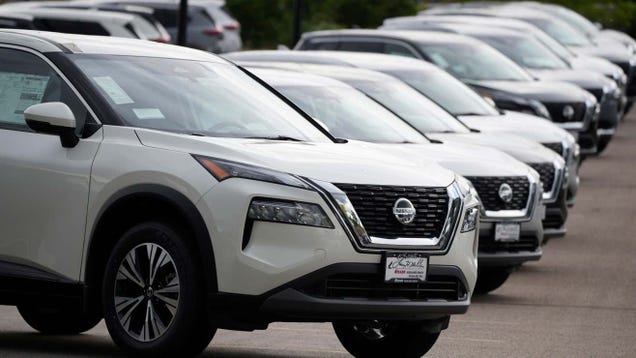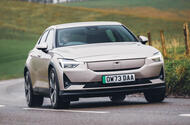Featured
Nissan’s Struggles: Unraveling the Challenges Holding the Automaker Back

Nissan has been in a difficult spot for a while, but recently the automaker’s problems are even more pronounced. There are two key, but intertwined factors that are holding Nissan back, and I’m not sure any kind of investment or change in company direction can overcome them.

Warranty Woes: Student Mechanic Faces Hyundai Dealer’s Denial on Engine Failure

A Canadian student mechanic got a rude awakening when a local Hyundai dealer refused to honor the automaker’s warranty for his Elantra N’s blown engine. Christian Matzoros bought the 2022 Elantra N just two years ago – paying for an extended warranty that made him think he had complete coverage for seven years 140,000…

Hyundai Inster: A Compact Electric Car for the Mass Market

Inster measures 3.8m long, 1.6m wide and 1.6m tallKorean brand aims to broaden appeal of electric cars with new miniature four-seater
Hyundai is gearing up for an assault on the mainstream electric car market with the new Inster, priced from £23,495 – or £249 per month on PCP finance.
It's based on the Hyundai Casper, a diminutive city car that has so far been sold exclusively with a petrol engine in Korea. Its platform has been stretched by 230mm (with a 180mm of that growth in its wheelbase), improving both practicality and the available space for an underfloor battery pack.
The Inster measures 3.8m long, 1.6m wide and 1.6m tall, which positions it between the Dacia Spring and the Citroën ë-C3.
Despite the car's smaller footprint, Hyundai insiders are confident that the Inster is as practical as its five-seat rivals, thanks to its efficient packaging and configurable interior. Its wheelbase almost matches that of the larger Hyundai i20, for example, and its four seats are more versatile than those in traditional hatchbacks. Each can be folded completely flat and the two rear seats are also capable of sliding and reclining to open up more leg room or boot space as it’s needed.
The Inster will be offered with two mechanical configurations at launch. Entry-level cars get a 96bhp front-mounted motor that delivers a 0-62mph sprint time of 11.7sec and a top speed of 87mph. It’s paired with a 42kWh battery pack, which is claimed to deliver a range of 186 miles between charges. The flagship ‘long range’ Inster is boosted to 113bhp and 49kWh, taking its range to 217 miles and its top speed to 93mph, while reducing its 0-62mph time to 10.6sec.
Both versions use the nickel-manganese-cobalt (NMC) chemistry and all Insters get a heat pump and 85kW (DC) charging capabilities as standard.
Although those specifications place the Inster roughly on a par with its classmates, Hyundai believes that it will stand out for its interior connectivity and on-board technologies.
Inside, all versions get a pair of 10.25in digital displays (an instrument panel and an infotainment touchscreen), and you can use your smartphone as a ‘key’ to unlock and start the car.

The Inster also gets Hyundai’s full suite of advanced driver assistance systems (ADAS), including a 360deg parking camera, adaptive cruise control and the Korean brand’s novel blindspot monitoring system, which projects a camera image of your rear quarter view onto the instrument panel as you indicate.
Deliveries of the Inster are set to start by next spring. UK customers will be offered both battery options and two trim levels, named 01 and 02.
Kit including the digital instrument panel, infotainment touchscreen, rear-view camera and automatic headlights are standard. However, to get the sliding rear bench, flat-folding front seats or LED headlights you have to opt for 02 trim, priced from £26,745.
“We believe we will start electrification not only for the early adopters but for the mass market,” said Paolo Gnerro, product planning manager for Hyundai Motor Europe.
He explained that the company is targeting two new types of customers with the Inster: “very young”, potentially buying their first new cars; and “empty-nesters – families with kids already [moved out of] home, mainly in their 50s”, who want a second car for running errands.

Gnerro added that he believed the Inster would operate outside the traditional size-bound segments, pointing to changing customer behaviours with EVs.
He explained: “They were not saying 'this is a 3.8m car; it’s A-segment'. They were segmenting the cars depending on the range, no matter the size of the car. For them, a 350km-range [217-mile] car is comparable to another 350km car, no matter what the size is.”
A Lifelong Love Affair with Cars
If you’re like most of us here at Jalopnik, then you have likely been infatuated with the wonderful world of automobiles for as long as you can remember. I still remember the cars that all of my teachers drove, from preschool Miss Jennifer’s bright red 19999 Honda Accord coupe to my my senior year high school…

Polestar’s Leadership Shift Signals Hope Amid Sales Decline

Sales of the Polestar 2 have fallenAppointment of a former CFO to lead the start-up tells all about its situation but there's hope on the horizon
Polestar’s announcement in August that it was switching CEOs provided a window on the ailing condition of the electric car start-up spun out of Volvo.
The CVs of the two CEOs were instructive. Out went former design boss Thomas Ingenlath and in came former chief financial officer Michael Lohscheller.
Ingenlath had been promoted from his role as head of design of Volvo in 2017 to form a new electric subsidiary with aesthetics at its core.
Seven years on, Polestar products have the looks and quality to match those of a mature car company. But as the appointment of industry veteran Lohscheller suggests, the company’s finances are as bad as any start-up's.
Lohscheller, former CFO and then CEO of Opel, has become a go-to guy for embattled start-ups looking for solid guidance from an wily old industry hand. Since leaving Opel in 2021, he spent seven months as global CEO of Vietnamese brand Vinfast, then 19 months as president and CEO of infamous fuel cell hopeful Nikola.
Lohscheller’s fast cycling between jobs suggests he’s either become a short-term turnaround specialist or didn’t gel with those particular start-ups. Either way, he’s got insight into both ends of the automotive spectrum.
Polestar has suffered as badly as any electric start-up without actually hitting the buffers, Fisker-style. It got so bad that in February, Volvo decided it had to reduce its financial exposure to Polestar by cutting its stake from 48% to 18% and handing over the balance of shares to parent Geely.
Then in May, Polestar received a deficiency notice from New York tech-focused stock exchange Nasdaq for not having filed its annual report for the previous year on time. It eventually filed in mid-August, showing a net loss of $1.2 billion (£0.9bn) on revenue of $2.4bn (£1.8bn).
Sales of its single vehicle – the 2 electric saloon - have fallen, even in the UK where it competes in the EV-friendly corporate market. Registrations to the end of August in 2024 stood at 3863, down from 8981 the year before.
More bad news followed in July, when Polestar received a warning that its shares had fallen below the minimum $1 worth and faced delisting from Nasdaq. In August, the company’s value based on its share price was just $1.14bn (£0.87bn), down from a high in 2022 of more than $21bn (£16bn).
“Material uncertainty about Polestar's ability to continue as a going concern persists,” the company said in its delayed financial report.
Polestar could have fallen into the same doom spiral as Fisker but it is far more fortunate in that it benefits from the support and influence of parent Geely. In February, Polestar announced that it had secured $950 million (£725m) in funding from a range of international banks, keeping the money flowing until such time as it can reliably generate its own.
It also took the chance to shake up its leadership, both executive and non-executive. Along with the exit of Ingenlath, Polestar announced the retirement of chairman Håkan Samuelsson, a former CEO of Volvo, and installed in his place former Skoda CEO and ex-VW heavyweight Winfried Vahland. Meanwhile, a new chief financial officer, Jean-François Mady, was appointed from Stellantis.
The company has also been cutting costs in part by reducing headcount by 500 last year through the means of a hiring freeze. That might not sound a lot compared with, say, Volkswagen but Polestar has only 2523 employees, according to the annual report.
The reason Polestar has so few workers is that it runs what Geely calls an ‘asset light’ model, whereby it pays other Geely group companies to develop platforms and technology, and also build its cars. Geely group brands tend to have a speciality when it comes to vehicle development, which they can then use to offset their bills by selling to other parts of the company.
Polestar’s 650-strong development team, for example, focuses on bonded aluminium architectures, high-power electric motors, bi-directional compatible battery packs and in-car software development.
Meanwhile, Polestar pays Volvo to build its new Polestar 3 large SUV, and Zeekr to build the new Polestar 4 coupé-SUV in China. It also pays a licence fee to use Geely platforms, such as Geely’s PMA-1 platform and GEEA2.0 electrical architecture for the 4. The upcoming Polestar 5 sports saloon, planned for 2025, will use Zeekr's new ZEEA2.5 architecture.
Theoretically, this method cuts Polestar’s development bill and speeds up the creation of new models. The access to Geely’s global network means it can dodge tariff-related problems that other Chinese rivals such as Nio and Xpeng can’t yet – for example, making the 3 in Volvo’s US plant and eventually the Renault-Geely factory in South Korea for the 4.
Polestar appears to be turning a corner. Shares in the company rose in early September to levels not seen for a year, valuing Polestar at the end of September around three times its August figure. On 17 September, Polestar announced it had been told by Nasdaq that the share price was high enough to lift the threat of delisting.
Perhaps the biggest boost for the brand is that it now sells three models instead of just one. The pricier 4 and 3 will help cement the brand’s premium positioning, albeit one that brings the likes of Porsche into the competitor pool, along with BMW, Audi and Mercedes-Benz. The company is targeting positive cash flow (a measure of profitability) for late next year.
Polestar is not about to run out of cash, with the $950m injection earlier this year as well as Volvo’s promise to extend its credit facility to the company to $1bn to the end of 2028. Geely’s network of companies, meanwhile, continue to innovate in platforms, electric tech and manufacturing. Geely’s heft should also secure Polestar good deals on batteries.
With the new management team in place, Polestar can now cross the bridge “from a start-up to an established, leading player”, outgoing chair Samuelsson said in August. In doing so, it’ll be hoping the bad news bears of 2024 will have been soundly chased away.
